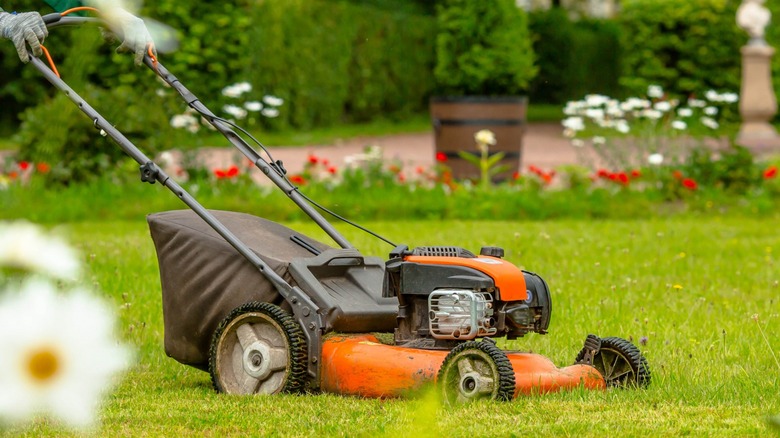
Julia Klueva/Getty Images
By Ron King/
Cutting grass with sharp lawn mower blades is essential to maintaining a healthy, attractive lawn. While sharpening lawn mower blades isn’t a job for everyone, it is a straightforward DIY project. The hardest part of the project is removing the blade from the mower.
Popular Mechanics recommends tilting a push mower «so the air filter is facing up,» but keeping the spark plug on the high side is also a good idea. This arrangement helps to keep excess oil and gasoline out of the engine’s cylinder if any of those fluids leak a little. You should consult your owner’s manual for riding mower blade removal instructions.
Other precautions include removing the wire from the spark plug and tying it back to ensure it cannot make contact with the spark plug. The mower can’t start with the plug wire disconnected. If you have an electric lawn mower, remove the power source before attempting to remove the blade. Once the blade is free from the mower, it’s time to sharpen it.
Using a file for sharpening lawn mower blades
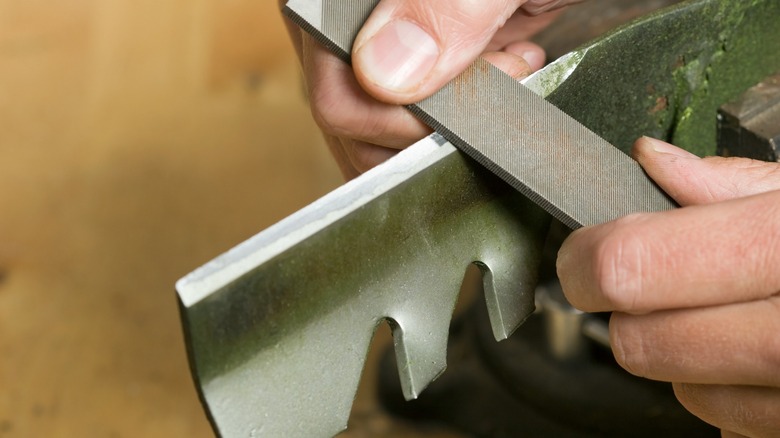
Banksphotos/Getty Images
A file is one of the simplest and cheapest tools for sharpening lawn mower blades. Suitable file types include 10- to 12-inch mill, flat, and hand files, provided they have a coarse cutting profile known as «bastard cut.» The three file types listed vary in how they taper in thickness and width. One type may suit you better, but it comes down to personal preference, and all three will sharpen your mower blades.
It’s best to place your dull lawn mower blade in a vise or securely clamp it to a sturdy workbench to sharpen it. You’ll also want to remove old grass clippings, dirt, and surface rust with a wire brush before you begin. Now look at the existing blade angle where the manufacturer sharpened it before. You’ll want to match that angle with the file, so position the blade to make it as easy as possible.
The file only cuts when pushing it away from you. Start with the forward end of the file near the base of the mower blade’s cutting edge and firmly push the file away from you and along the cutting edge. It takes some pressure, but there is a balance between forcing it and letting the file do the work. Keep a count of the number of strokes it takes to restore the edge and match it on the other side. Any significant nicks or severely degraded blade shapes will require a new blade.
Using an angle grinder for sharpening lawn mower blades
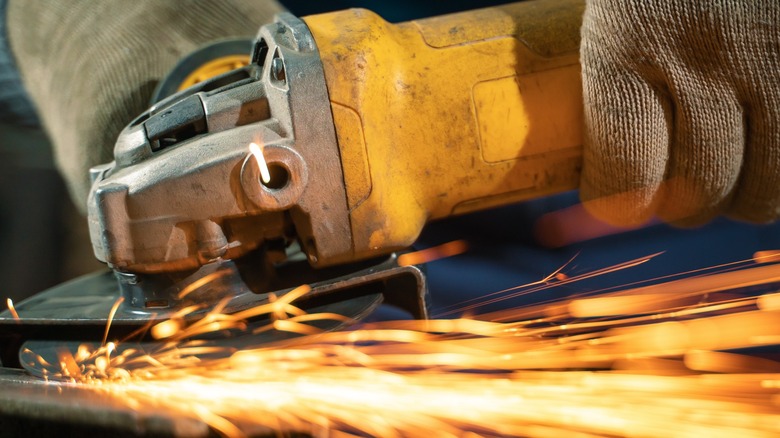
Aleksandr Rybalko/Shutterstock
Using an angle grinder to sharpen lawn mower blades is much faster than a file. It’s also a much quicker way to destroy your lawn mower blade if you’re not careful. Ensure your angle grinder has a grinding wheel or flap disc suitable for removing metal. It’s also a good idea to wear proper eye protection and ensure your workspace is suitable for a shower of hot sparks.
With the blade securely attached to a workbench, restore the lawn mower blade’s edge by matching the angle with the grinder. You’ll want to move along the edge quickly to prevent overheating the metal which could weaken it. Also, try to use the flattest portion of the grinding disc and avoid touching the blade with the edge of the disc to prevent nicks and gouges. Similar to the file method, keep the number of strokes even on both ends of the blade to maintain the blade’s balance.
Using a Dremel grinder for sharpening lawn mower blades
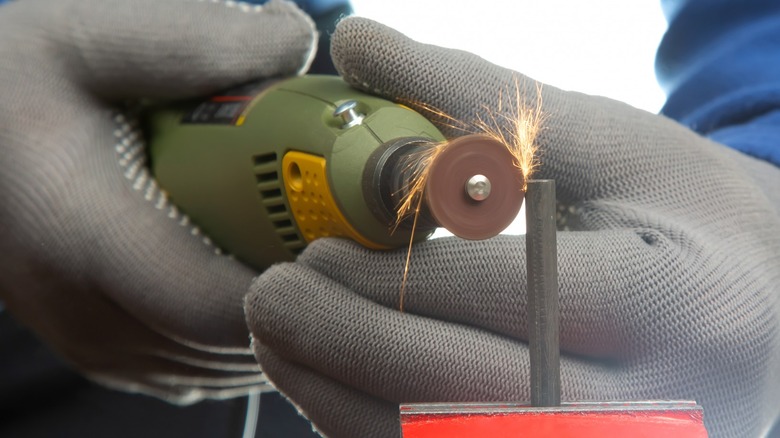
Photosaint/Getty Images
While a Dremel rotary tool isn’t necessarily the best choice for sharpening lawn mower blades, their popularity makes them worth mentioning here. Like other methods, matching the existing blade angles and keeping the blade balanced are vital considerations. Unlike files and angle grinders, Dremel simplifies lawn mower blade sharpening with its «Lawn Mower Sharpening Attachment.»
Dremel boasts its specialty tool is «the fastest, easiest way to sharpen lawnmower blades.» While the attachment will help maintain a standard fixed angle, it may not match the angle of your lawn mower blades. If it doesn’t match, you’ll have to manually adjust or change the angle of your blade, which could require considerable work with a Dremel.
Maintaining smooth strokes is critical whether or not you use the Dremel lawn mower blade attachment. Using jerky motions while sharpening lawn mower blades with a Dremel could result in a wavy blade edge that may not perform as desired.
Using a bench grinder for sharpening lawn mower blades
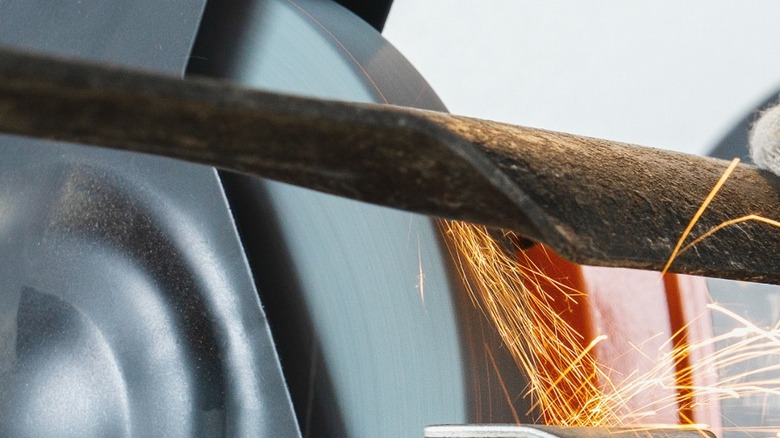
Medvedeva Oxana/Shutterstock
Unlike files, angle grinders, and Dremels, bench grinders require holding the lawn mower blade with your hands to sharpen it. Like the angle grinder, using a bench grinder to sharpen lawn mower blades produces sparks and requires eye protection. However, even though the metal blade will become warm, it’s best to avoid wearing gloves. First, the grinding wheel could catch the glove, resulting in bodily injury. Second, you don’t want the blade to get so hot that it affects its hardness.
After equipping the bench grinder with a suitable grinding wheel and adjusting the tool rest properly, present the lawn mower blade to the grinding wheel with the cutting edge up. Move the blade so the cutting edge smoothly slides past the grinding wheel, taking care not to overheat the metal. If the metal edge begins to darken or change color, it’s getting hot, and you need to move faster.
Using a dedicated lawn mower blade sharpener
Investing in a dedicated lawn mower blade sharpener might make sense if you plan to sharpen several lawn mower blades yearly. Some devices, like All American Sharpener, mount to your workbench and require using your angle grinder. Others, like Vevor, provide an all-in-one solution for sharpening lawn mower blades. Expect to spend about $200 to $300 on quality equipment. While that sounds like a lot, the ease and convenience of accurately sharpening your lawn mower blades at home soon pays for itself.
Maintaining blade balance is critical for whichever tool you choose for sharpening your lawn mower blades. Unbalanced blades result in excessive vibration that could damage your mower’s bearings and seals, shortening its life.
An Oregon Products Precision Blade Balancer is an excellent tool for checking lawn mower blade balance. Another simple way is to drive a small nail into a vertical surface like a wall or side of a workbench and hang the blade by the center hole horizontally.
When should you sharpen your lawn mower blade?
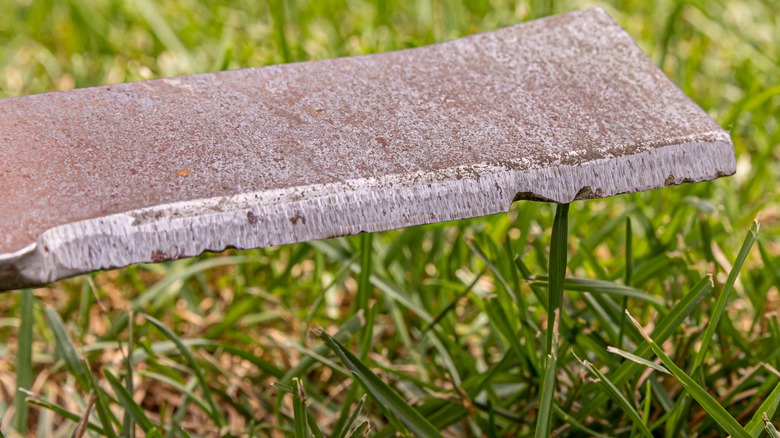
J.J. Gouin/Shutterstock
Your lawn mower blade must be sharp to avoid tearing the grass instead of cutting it cleanly. Depending on various factors, such as the size of your lawn, type of grass, debris, and sand, you may need to sharpen your lawn mower blade several times per season.
While it seems logical to sharpen your lawn mower blade at the start of the mowing season, it might serve you better to do it at the end. Performing end-of-season lawn mower maintenance leaves plenty of time for ordering parts, ensures your mower is clean – eliminating any potential for trapped moisture to cause corrosion, and keeps your carburetor clean. Fall is an excellent time to sharpen or replace your lawn mower blades and spray the underside with WD-40 before putting it away for the winter. In addition, any maintenance done at the end of the season reduces the work required before the next mowing season starts.